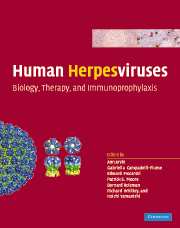Book contents
- Frontmatter
- Contents
- List of contributors
- Preface
- Part I Introduction: definition and classification of the human herpesviruses
- Part II Basic virology and viral gene effects on host cell functions: alphaherpesviruses
- Part II Basic virology and viral gene effects on host cell functions: betaherpesviruses
- Part II Basic virology and viral gene effects on host cell functions: gammaherpesviruses
- Part III Pathogenesis, clinical disease, host response, and epidemiology: HSV-1 and HSV-2
- Part III Pathogenesis, clinical disease, host response, and epidemiology: VZU
- Part III Pathogenesis, clinical disease, host response, and epidemiology: HCMV
- Part III Pathogenesis, clinical disease, host response, and epidemiology: HHV- 6A, 6B, and 7
- Part III Pathogenesis, clinical disease, host response, and epidemiology: gammaherpesviruses
- Part IV Non-human primate herpesviruses
- Part V Subversion of adaptive immunity
- Part VI Antiviral therapy
- 64 Antiviral therapy of HSV-1 and -2
- 65 Antiviral therapy of varicella-zoster virus infections
- 66 Antiviral therapy for human cytomegalovirus
- 67 New approaches to antiviral drug discovery (genomics/proteomics)
- 68 Candidate anti-herpesviral drugs; mechanisms of action and resistance
- Part VII Vaccines and immunothgerapy
- Part VIII Herpes as therapeutic agents
- Index
- Plate section
- References
67 - New approaches to antiviral drug discovery (genomics/proteomics)
from Part VI - Antiviral therapy
Published online by Cambridge University Press: 24 December 2009
- Frontmatter
- Contents
- List of contributors
- Preface
- Part I Introduction: definition and classification of the human herpesviruses
- Part II Basic virology and viral gene effects on host cell functions: alphaherpesviruses
- Part II Basic virology and viral gene effects on host cell functions: betaherpesviruses
- Part II Basic virology and viral gene effects on host cell functions: gammaherpesviruses
- Part III Pathogenesis, clinical disease, host response, and epidemiology: HSV-1 and HSV-2
- Part III Pathogenesis, clinical disease, host response, and epidemiology: VZU
- Part III Pathogenesis, clinical disease, host response, and epidemiology: HCMV
- Part III Pathogenesis, clinical disease, host response, and epidemiology: HHV- 6A, 6B, and 7
- Part III Pathogenesis, clinical disease, host response, and epidemiology: gammaherpesviruses
- Part IV Non-human primate herpesviruses
- Part V Subversion of adaptive immunity
- Part VI Antiviral therapy
- 64 Antiviral therapy of HSV-1 and -2
- 65 Antiviral therapy of varicella-zoster virus infections
- 66 Antiviral therapy for human cytomegalovirus
- 67 New approaches to antiviral drug discovery (genomics/proteomics)
- 68 Candidate anti-herpesviral drugs; mechanisms of action and resistance
- Part VII Vaccines and immunothgerapy
- Part VIII Herpes as therapeutic agents
- Index
- Plate section
- References
Summary
Introduction
Discovery of antiviral drugs has always been an opportunistic endeavor. Small molecules in general and nucleoside analogues in particular have led investigators to discover uncharacterized viral gene products that could be exploited for the purpose of antiviral chemotherapy. Great strides have also been made in understanding fundamental events in the viral replication cycle including the binding of viral glycoproteins to cellular receptors, viral regulatory proteins that control expression of viral and cellular gene expression, viral genes that affect the synthesis and packaging of the viral genome, and viral factors that subvert the host immune response (Whitley and Roizman, 2001). Many of the viral genes that contribute to these processes are known and for some of them, the precise function is understood at the molecular level. For these targets it is comparatively simple to reduce the essential function to a biochemical assay, such as a polymerase or protease assay for use in a high throughput screen in order to identify small molecule inhibitors of enzyme function (Liu and Roizman, 1993). This approach has facilitated the proactive and rational search for specific enzyme inhibitors and has led to the development of effective antiviral therapies. Although this approach is effective, it requires well-characterized targets with a defined biochemical function, and can be applied only to a very small proportion of the essential viral gene products. At present, the best targets for antiviral chemotherapy likely remain undescribed and unutilized.
- Type
- Chapter
- Information
- Human HerpesvirusesBiology, Therapy, and Immunoprophylaxis, pp. 1211 - 1218Publisher: Cambridge University PressPrint publication year: 2007
References
- 1
- Cited by

